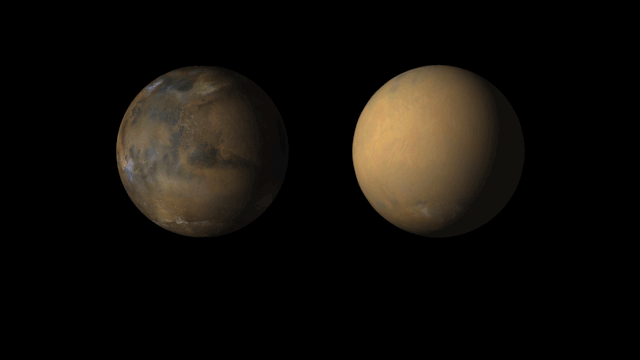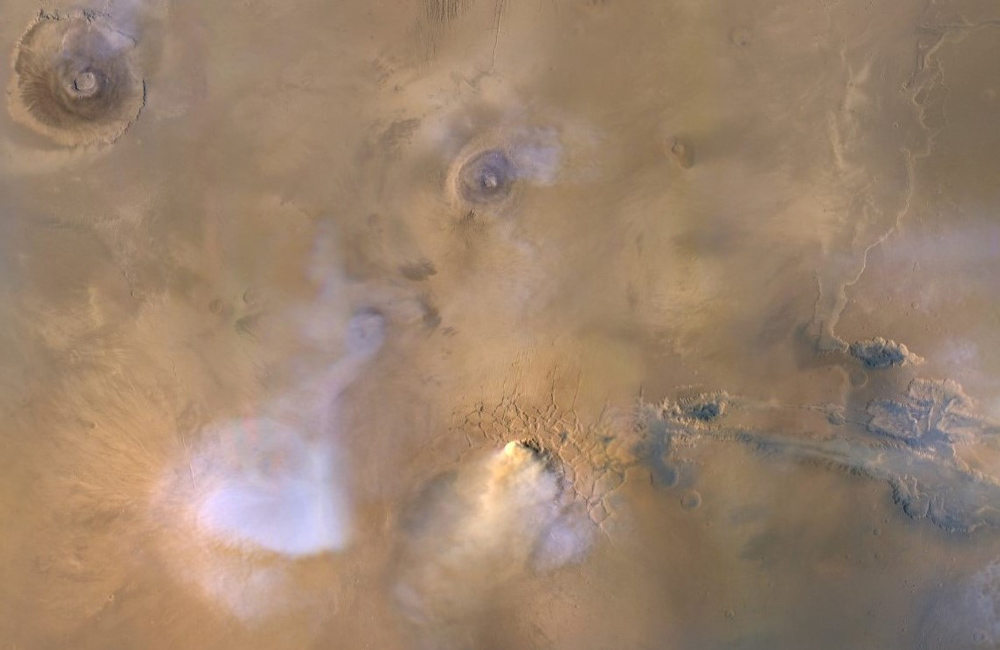Massive 'Dust Towers' on Mars Look Like Supersized Versions of Earth's Thunderstorms

Massive dust towers on Mars that formed during global storms may be "space elevators" that contributed to the loss of the planet's ancient water, according to NASA's description of new research.
Dust towers can loom dozens of miles above Mars' surface and are part of larger dust storms that sweep up the planet's iconic reddish dirt, blanketing the world. One giant storm last year brought NASA's Opportunity mission to an end and masked Mars' features in a dull coating of dust, as seen in an incredible moving image from NASA's Mars Reconnaissance Orbiter. The scientists behind the new research said they wanted to better understand how storms like these work.
During a global storm, dust towers "are renewed continuously for weeks,'' the lead author for both papers, Nicholas Heavens of Hampton University in Hampton, Virginia, said in a recent NASA statement about the dust towers. The space agency said that in some cases, it observed multiple towers for as long as 3.5 weeks. These structures stretch upward, much like thunderstorm clouds do on Earth, and the researchers said the dust towers may have played a part in the evaporation of Mars' ancient water into space.
Related: Watch Clouds on Mars Drift by in Supercomputer Simulations
The sight of an Earthly thunderstorm cloud is unmistakable: The tall formation is ominous, and people exercise caution after spotting one, as the cloud could bring dramatic atmospheric activity like a lightning strike. Thunderstorm clouds grow tall because of the sun; as the heat from the star warms the moisture in Earth's atmosphere, water particles ascend higher into the sky.
That heat also powers dust towers on Mars. The dust clouds, described in NASA's statement as "space elevators," lift particles of water and dirt that have hitched a ride on the rising dust streamers that create the cloud. The updraft carries water vapor and one of its gaseous building blocks, hydrogen, up to the planet's upper atmosphere; here, in Mars' ancient past, these particles may have then evaporated and disappeared from the Red Planet in large quantities.
To understand how Earthly thunderstorm clouds affect our daily lives, meteorologists study the larger phenomenon, known as deep convection, that produces them. Mars has a deep convection system as well, and the scientists behind the new research studied that system for answers about Martian dust storms.
Breaking space news, the latest updates on rocket launches, skywatching events and more!
The first of the two recent papers published by Heavens' team laid out a framework for how to study this Martian convection system. Researchers called the Red Planet's atmospheric conveyor belt "dusty deep convection."
In their more recent paper, the researchers studied the last two dust events that engulfed Mars, which occurred in 2007 and 2018, and how water molecules were moving around the planet at the time.
There are still some mysteries about dust towers and the role they play in massive dust storms. One idea is that the dust towers form randomly from lifted dust; another is that they come together as hurricane-like storms that then envelop the planet in dust.
The November 2019 study was published in the Journal of Geophysical Research, and the October 2019 study was published in the Journal of the Atmospheric Sciences.
- Water on Mars: Exploration & Evidence
- NASA Spacecraft Spots 'Star Trek' Logo on Mars
- Bam! Fresh Crater Spied on Mars — and It Looks Spectacular
Follow Doris Elin Urrutia on Twitter @salazar_elin. Follow us on Twitter @Spacedotcom and on Facebook.


Doris is a science journalist and Space.com contributor. She received a B.A. in Sociology and Communications at Fordham University in New York City. Her first work was published in collaboration with London Mining Network, where her love of science writing was born. Her passion for astronomy started as a kid when she helped her sister build a model solar system in the Bronx. She got her first shot at astronomy writing as a Space.com editorial intern and continues to write about all things cosmic for the website. Doris has also written about microscopic plant life for Scientific American’s website and about whale calls for their print magazine. She has also written about ancient humans for Inverse, with stories ranging from how to recreate Pompeii’s cuisine to how to map the Polynesian expansion through genomics. She currently shares her home with two rabbits. Follow her on twitter at @salazar_elin.

